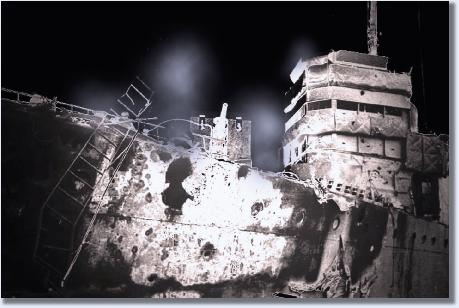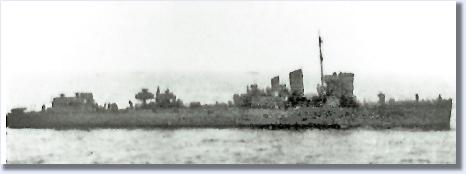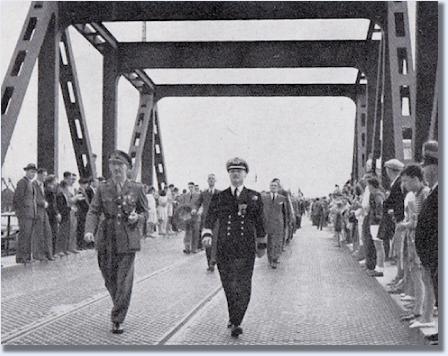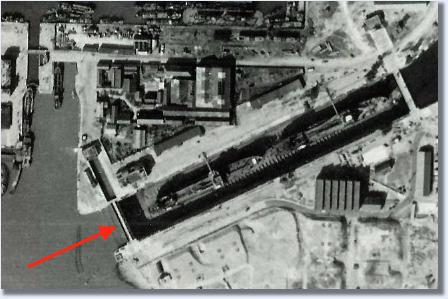All material contained in this site is subject to copyright and must not be reproduced in any format without the consent of the relevant copyright holder
The Story of 'Operation CHARIOT'

HMS Campbeltown, smouldering, abandoned and firmly wedged in the dry dock gate, makes a very convincing show of no longer being a threat. (James Dorrian 2012)
Late in 1938, Germany embarked on a plan - PLAN Z - which was designed to provide Germany with a battle fleet of such power that by the late 1940s it would be able to challenge the might of the British Royal Navy.
The proposed fleet of battleships and aircraft carriers looked very good on paper; however the war they were designed to dominate began almost a decade too soon, leaving the Kriegsmarine with only two of their battleships in building, these being the mighty Bismarck and Tirpitz, ships so powerful that no single adversary could be certain of defeating them in a one to one engagement.
In combination with the burgeoning U-Boat fleet, these two huge ships had the capacity, if used wisely, to sever the Atlantic convoy lifeline that effectively kept Britain in the war. But instead of setting sail as a single immensely powerful unit, Bismarck, the first to become operational, was sent into the Atlantic in the company of only the heavy cruiser Prinz Eugen - an error of significant proportions, as history would soon prove. So great was the panic engendered by Bismarck's solitary foray into the North Atlantic, that a major proportion of the Royal Navy's assets were diverted from already urgent tasks to bring her to book. In the event she was indeed caught and sunk, but only after the kind of loss and lengthy chase, that would later colour reactions to the prospect of her sister-ship following in her footsteps.
Perhaps only a minor consideration at the time was Bismarck's intention, having been damaged by air attack, to steam for the occupied French Atlantic port of Saint-Nazaire for repair within the Forme Joubert, one of the largest dry docks in the world and the largest within reach of the Atlantic wastes. Later, however, in considering Tirpitz's intentions, the presence of this huge dock would assume critical proportions, it having been judged that, were this dock to be destroyed, Tirpitz might not, after all, commit herself to a sortie whose only result might be her own destruction.
German U-Boats and warships usually 'worked-up' in the relative safety of the Baltic Sea. When ships and crews were considered fit for action and declared operational, they left the Baltic and, given the extreme dangers inherent in trying to force the English Channel, sailed for their Atlantic operational areas via the North Sea and either the Iceland-Faeroes Gap, or the Denmark Strait. For Germany's heaviest ships the first ports of call would be on the Norwegian coast where were to be found maintenance and supply facilities, and deep fjords within which to hide from watchful eyes.
When, Tirpitz passed through the Kiel Canal on Wednesday 14th January, 1942, and made for Norway, the spectre therefore arose of her breaking into the Atlantic, joining with the Battle-Cruisers Scharnhorst and Gneisenau, then in Brest, and, in conjunction with the predations of the U-Boats, executing a potentially terminal strike against the convoy supply lines which were vital to Britain remaining in the war.
Given that, were Tirpitz to sustain damage requiring dockyard facilities, she would either have to return to Germany via a North Sea certain to contain a waiting British fleet, or, as with Bismarck, head for the occupied French Biscay ports, a plan was immediately called for that would at least deny her the use of the Forme Ecluse in Saint-Nazaire.
Constructed specially for the luxurious 'Blue Riband' liner Normandie, and now more popularly known as the 'Normandie' Dock, the Forme Ecluse had long been a target of strategic interest, but one whose defences, both man-made and natural, had thus far defeated every attempt to find a way of overcoming them. Too small to be destroyed from the air, yet, with caisson gates weighing in at 1,500 tons when ballasted with sea-water, much too strong to be destroyed by torpedoes alone, its powerful and growing gun defences only added to the security provided by its position six miles inside a river estuary where extensive shoals confined any approach to a single, narrow, deep-water channel.
Cue Winston Churchill who demanded of Lord Louis Mountbatten's nascent Combined Operations Command, that some way MUST be found to neutralise the dock before British naval strategy in Northern waters became effectively paralysed by the need to retain several precious capital ships in home waters - just in case.
As the relatively new Chief of Combined Operations, the charismatic Mountbatten had been tasked with mounting raids on the enemy coast with the aim of keeping the enemy off balance and preparing the ground for an eventual full-scale invasion. Although the name of his new command implied cooperation between all three services, this was, in early 1942, more ambition than reality; and while Mountbatten had in the Army Commandos his own elite fighting force he possessed no air or naval assets to call his own.
Under huge pressure, Mountbatten's team knew that, while actually getting the men onto target presented huge difficulties, at least they could rely fully on the young Army Commandos to do what would be asked of them.
Having for many months suffered at the hands of traditionalists determined to subvert the formation of any such military elites, these ardent young soldiers, chosen as much for their intelligence as for their fighting abilities, were chafing at the bit in their wild Scottish training areas, desperate for some way of showing what they could really do. It was a desire for action that would cause them not to look too closely into the enormous risks involved.
For risks there were aplenty. As 'storm troops' they would have to carry everything they needed with them: weapons and ammunition sufficient to take on a vastly superior (in numbers) enemy force, plus enough explosive charges to destroy an ever-growing catalogue of targets. This, always assuming some way could be found of transporting them 420 miles through the German-controlled Bay of Biscay without anyone realising they were there. Following which there would be the potentially suicidal penetration of a port known to be the second most heavily defended outside Germany.
In the event the answer was found not to lie in guns or armour, but in the high spring tide which, during a few precious days at the end of March, would cause enough water to sweep across the estuary shoals to afford light ships a passage that would not rely on the defended deep-water channel, Always assuming a Combined force could be assembled in time, Saint-Nazaire might therefore be approached from a direction thought by the port's defenders to be impassable - their complacency perhaps occasioning the surprise Mountbatten knew was their key to success.
'March closed for us with the brilliant and heroic exploit of St. Nazaire....here was a deed of glory Intimately involved in high strategy' (Winston Churchill 'The Hinge of Fate')
With a window of opportunity in sight, Mountbatten set about constructing a 'Combined' force, of naval ships to carry the Commandos to Saint-Nazaire and, hopefully, bring them home again, and of the aircraft it had been determined were vital for staging a diversionary air raid. This, however, proved to be easier said than done, as the Navy, in spite of deterring Tirpitz being clearly to its advantage, initially refused to provide the destroyer Mountbatten planned to fill with explosives and explode after ramming the dock gate, and, now under Arthur Harris, Bomber Command was not at all keen to divert aircraft from its burgeoning campaign against German cities.
All of which meant that when 341 sailors and 264 commandos finally sailed from Falmouth to initiate Operation Chariot. it was on board unsuitable ships - wooden Motor Launches and an antiquated ex-American World War One destroyer now in British Service - with inadequate weapons, short of ammunition, denied effective gun or air support, and yet determined absolutely to sacrifice themselves to save their Merchant Navy comrades from destruction by Tirpitz' s massive guns.
Commander Robert Ryder, RN, the Naval Force Commander, having come up with a ruse to deflect the enemy's attention, the unlikely fleet maintained the pretence of an anti-submarine sweep as it entered the Bay of Biscay. En-route they were actually spotted by an enemy U-Boat which, misinterpreting their intentions, fortuitously reported them as sailing away from the French coast rather than towards it. This was the first in a succession of blunders on the part of an enemy who, convinced of their invulnerability, not only let the Chariot force reach the estuary of the River Loire unopposed, but also let them penetrate deep within it before the defences finally woke to the danger.

HMS Campbeltown (originally USS Buchanan) photographed en route to Saint-Nazaire by Sub-Lt. David Stogdon, HMS Tynedale's Gunnery Officer. She is disguised as a German destroyer of a class known to the defenders. More than 4 tons of high-explosives are buried deep within her hull immediately below the forward gun.
Having, as a last desperate, ploy used intercepted German signals to persuade the German batteries that the fleet was, in fact, friendly, the ships were not fired on until they reached the estuary narrows. Then 'all hell broke loose' as a mass of guns began to pour shells into the force from both estuary shores.
Unarmoured, fuelled by petrol and carrying only single 20mm light cannon, the little ships had no way of defending themselves effectively. Many burst into flames as their fuel tanks were hit: others circled helplessly as they tried to land troops at positions already blocked by the wreckage of those that had gone in first. Of six launches attempting to come alongside the fortified Old Mole, only one succeeded in putting men ashore. Nor was the situation any less fraught at the second landing site in the Old Entrance, where a mere two troop-carrying boats managed to disembark their men. Only at the dry dock was success achieved in full with Campbeltown, by dint of her steel hull and her officers' exemplary skill, survivng the maelstrom to disgorge her 78 Commandos onto the dockside.
The 350 metre long 'Normandie' dry dock, on the eve of the attack, with the tankers Passat and Schledstat on the blocks. Campbeltown's line of approach is shown in red.
Scuttled precisely in place, her explosive charge wedged tight against the caisson, this one ship wanted only time for her fuses to activate and blow the massive structure to pieces. Meanwhile her troops surged through nearby German defences, speedily to command the area within which squads of Demolition troops could lay and fire their own charges - in the vital Pumping Station, and in the two Winding Houses which opened and closed the inner and outer caisson gates.
Having practised through endless hours, by day and by night, in the docks of Burntisland, Cardiff and Southampton, the Demolition teams completed their complex tasks well within the alotted time. Immediately they were clear these all-important ancillary targets were blown up - leaving the final great explosion of Campbeltown's charge to underscore a truly stunning success.
And then came the reckoning. As the depleted teams came together where their commander, Lieutenant-Colonel Charles Newman had established a tenuous HQ in the face of withering fire from enemy in and around the U-Boat pens, they confidently expected to be carried home by the same small boats that had brought them to Saint-Nazaire. Their reaction, therefore, was one of dismay when they saw that their wooden fleet was burning furiously amidst clouds of oily smoke out in the estuary. At this point lesser men might have been persuaded that surrender was the only sensible course of action. However, these were Commandos who, in spite of being surrounded by an enemy vastly superior in numbers, remained confident they still held a potentially decisive advantage in respect of training and offensive spirit, Still full of fight the decision was therefore taken to do things the Commando way - to sieze the initiative, fight through their encirclement and, in small groups, or even as individual soldiers, make their own way to neutral Spain.
With their way into the main body of the town restricted to a single, closely-guarded lifting bridge (which the Germans had neglected to raise), this last element of their task seemed hopeless: and yet in one great charge the survivors shot and bombed their way across and through the German positions. Here, however, dreams of freedom began to crumble in the face of wounds, exhaustion and an almost completely depleted stock of ammunition. Captured singly, or in small groups, by an enemy wary of their prowess, the future for most would lie as PoWs in camps such as Stalag V111B, Spangenberg Castle or, in the case of especially 'uncooperative' guests of the Reich, the notorious fortress of Colditz Castle. A total of five men managed to evade capture and make their way back to the UK: others would spend their long years in captivity attempting to follow suit.
Faced with such daunting odds the success of the raid in knocking out the dry dock for the remainder of the war can only be described as a perfect validation of spirit, directed by enlightened training, as the soldier's most potent weapon. Particularly in the case of Colonel Newman's underused, Commandos, trailblazers as they were for today's Special Forces, their display of belligerence was absolutely typical of a group of very special young men chosen for their courage and initiative and trained to the point where they believed themselves superior to any foe.

Lieutenant-Colonel Charles Newman, VC and Commander Robert Ryder, VC, RN, lead veterans of the raid across the lifting bridge whose disputed passage they had forced with great courage back in 1942. The photograph was taken in 1947, at the time of the inauguration of the Monument du Commando on the Saint-Nazaire seafront.
